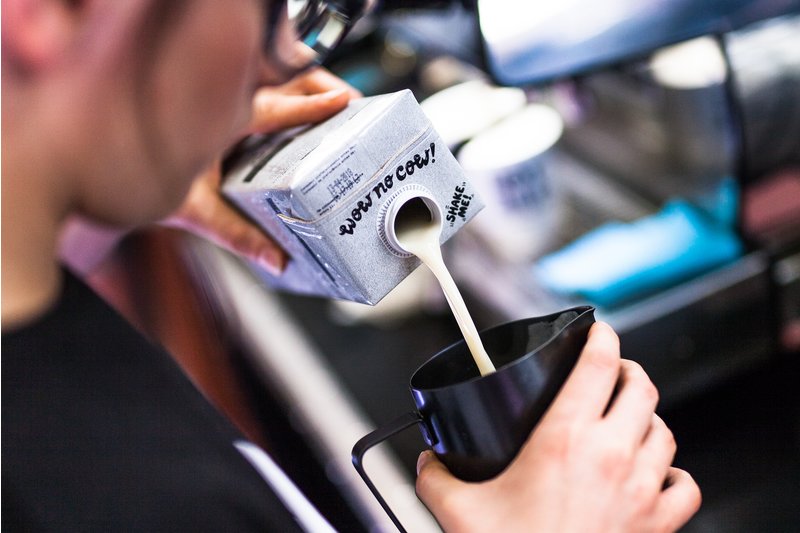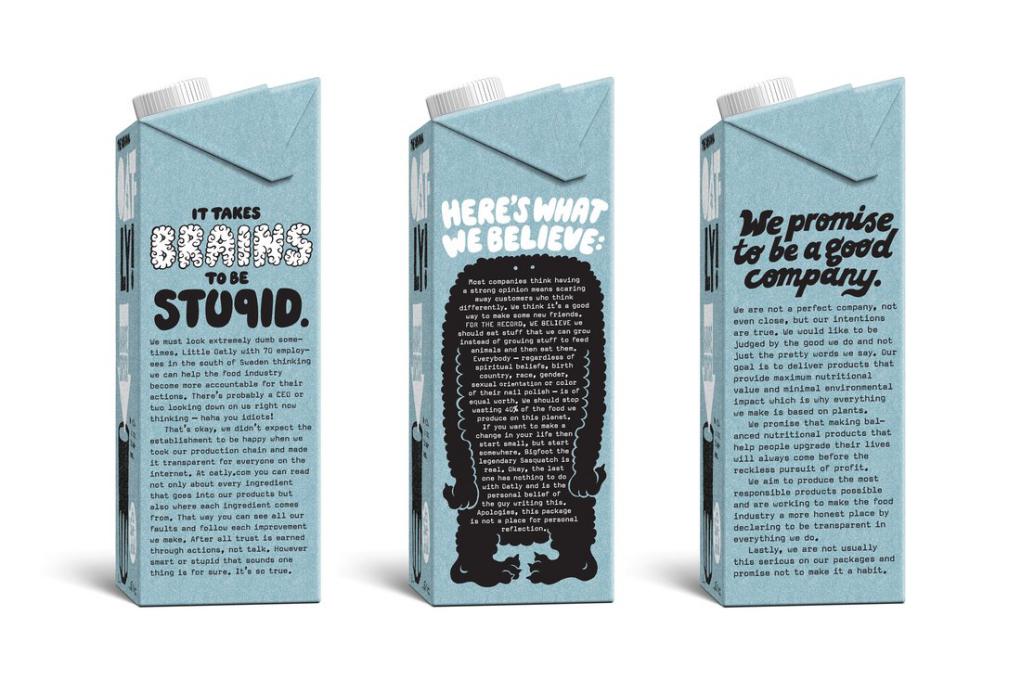
|
誰沒做過一夜成名走上人生巔峰的美夢(mèng)呢?但有一家名叫Oatly的瑞典燕麥乳公司卻真的做到了,。這家公司是由一位食品科學(xué)專業(yè)的教授創(chuàng)立的,。此前20多年,,它都只是植物飲料行業(yè)里一個(gè)籍籍無名的小字輩。但從幾年前開始,,它的知名度突然暴漲,,先是在歐洲搞出名堂,隨后在美國(guó)也火得一塌糊涂,。仿佛一夜之間,,到處都在談?wù)撨@家公司,它甚至還上了《紐約時(shí)報(bào)》,,對(duì)于一家2017年年初才登陸美國(guó)的公司,,它的成績(jī)可以說相當(dāng)了不起。 Oatly從一款默默無聞的產(chǎn)品躍升成一種文化現(xiàn)象,,離不開幾個(gè)因素的共同推動(dòng),。首先它的產(chǎn)品味道是相當(dāng)不錯(cuò)的(醇厚、飽滿是消費(fèi)者對(duì)它的常見評(píng)價(jià)),,另外植物奶市場(chǎng)總體上也呈增長(zhǎng)態(tài)勢(shì),。但如果該公司五年前沒有對(duì)品牌進(jìn)行重塑,恐怕今天知道它的人仍然不會(huì)太多,。 2013年,,該公司將約翰·斯庫(kù)克拉夫特任命為創(chuàng)意總監(jiān),負(fù)責(zé)為公司品牌形象注入新活力,。當(dāng)時(shí)斯庫(kù)克拉夫特對(duì)燕麥乳這種產(chǎn)品一無所知,,該公司的產(chǎn)品包裝也沒有什么打動(dòng)他的地方?!八鼪]有什么令人興奮之處,,只是讓人感到很無趣,跟其他產(chǎn)品沒什么區(qū)別,?!彼貞浀馈?/p> 斯庫(kù)克拉夫特與Oatly的CEO托尼·彼得森攜手瑞典知名營(yíng)銷公司Forsman & Bodenfors,,決心重新塑造新的品牌形象,。他們認(rèn)為,公司新的品牌審美應(yīng)該回歸質(zhì)樸,?!拔覀兿Mo人造成一種感覺,就是這些產(chǎn)品仿佛是在地下室里包裝的一樣,??傊覀兿M雌饋聿⒉幌褚粋€(gè)企業(yè)的品牌或者Logo”,。 包裝上的圖形是由F&B公司的設(shè)計(jì)師拉爾斯·埃爾夫曼手繪完成的,。包裝上的文案則由斯庫(kù)克拉夫特親自操刀,,最終的包裝頗有意識(shí)流的風(fēng)格,同時(shí)又真誠(chéng)而不做作地解釋了產(chǎn)品和公司的使命,。 在對(duì)燕麥乳進(jìn)行描述后,,包裝上還印了一句口號(hào):“它很像牛奶,不過是為人類制作的,?!?/p> |
You can call Oatly a 25-year-old overnight success story. Founded by a food science professor, the Swedish oat milk company spent decades as a niche player in the plant-based beverage industry. But a few years ago, its profile began to rise, first in Europe and now in the U.S. As if overnight, the company was being mentioned everywhere, including a buzzy feature in The New York Times. Not bad for a company who only fully entered the U.S. market in early 2017. A number of factors helped facilitate Oatly’s ascent from obscure product to cultural phenomenon: the product is tasty (buttery and rich are common descriptors), and the overall plant-based milk sector is booming. But if not for a major rebranding five years ago, the company would likely still be flying under the radar. In 2013, John Schoolcraft was brought on as creative director to breath new life into the look and feel of the company. Schoolcraft didn’t know anything about oat milk, and the company’s packaging didn’t do much to enlighten him. “It was uninspiring and boring,” he says. “It looked like everything else.” Schoolcraft and Oatly CEO Toni Petersson worked with the Swedish agency Forsman & Bodenfors to overhaul the brand. The new aesthetic was deliberately unvarnished. “We wanted it to feel like we were making these packages in the basement,” Schoolcraft says. “The whole idea was for it to not look and feel like a corporate logo or brand.” The type and images featured on the packaging were hand-drawn by Lars Elfman, a creative at Forsman & Bodenfors. Schoolcraft was responsible for coming up with the copy, which combined stream-of-consciousness musings with earnest but casual explanations of the product and the company’s mission. “IT’S LIKE MILK BUT MADE FOR HUMANS,” reads one tagline, followed by a description of oat milk. |

|
公司團(tuán)隊(duì)知道他們的產(chǎn)品雖然很好,但問題在于怎么讓人愿意嘗試它,。斯庫(kù)克拉夫特表示:“我們沒有很多的預(yù)算,,所以我們得把包裝當(dāng)成主要宣傳媒介。它們就相當(dāng)于超市里的廣告牌,?!卑b上的每一個(gè)設(shè)計(jì)元素,包括明亮的顏色,、泡泡狀的字體,以及用了很多感嘆號(hào)和問號(hào)的文案,,都是為了吸引消費(fèi)者拿起包裝盒,。(比如包裝上有一行字寫道:“對(duì),我們是素食主義者,,所以你呢,?”)這種精靈古怪的表達(dá)和描述都是為了說服消費(fèi)者購(gòu)買,只要他們?cè)敢赓I一盒嘗嘗,,產(chǎn)品就終于可以為自己代言了,。 該公司的品牌重塑取得了成功,歐洲地區(qū)的銷量開始迅速增長(zhǎng),,去年,,Oatly開始大張旗鼓進(jìn)軍美國(guó)。在下文中,,斯庫(kù)克拉夫特詳解了Oatly的這次品牌重塑何以取得成功,,以及廣大中小企業(yè)在塑造品牌形象時(shí)往往會(huì)掉進(jìn)哪些陷阱。 Otaly更像一個(gè)活生生的人,,而不是一個(gè)品牌 直到今天,,Oatly的廣告、包裝文案以及官網(wǎng)上的大部分文章都是由斯庫(kù)克拉夫特親自操刀的,。很多品牌的廣告語都是字斟句酌的商業(yè)語言,,但Oatly的文案往往帶著三分武斷、調(diào)侃和政治化的色彩,。(比如該公司官網(wǎng)是這樣描述產(chǎn)品的營(yíng)養(yǎng)信息的:“如果你想發(fā)電子郵件,,或者下載一部電影,,最好用光纖。如果你只想讓身體吸收一些纖維,,給身體一些營(yíng)養(yǎng),,那么喝一兩杯燕麥乳就很不錯(cuò)?!保?/p> 斯庫(kù)克拉夫特想讓消費(fèi)者知道,,經(jīng)營(yíng)這家公司的是有血有肉的人,而不是千人一面的“機(jī)器人”,。有時(shí)他也有些“用力過猛”,,他甚至?xí)炎约旱乃饺穗娮余]件地址寫在產(chǎn)品包裝盒背面。(不喜歡產(chǎn)品的人如果寫郵件給他報(bào)怨,,他就會(huì)回贈(zèng)一篇原創(chuàng)的小故事或打油詩,,平息對(duì)方的怒火。不過由于顧客發(fā)來的郵件太多,,6個(gè)月后他終于堅(jiān)持不下去了,,這種做法也只得告一段落。) 自從品牌重塑以來,,斯庫(kù)克拉夫特一直在堅(jiān)持不懈地寫新的文案,。他希望公司的品牌信息能少一些營(yíng)銷話術(shù),多一些與消費(fèi)者的對(duì)話,。他表示:“品牌重組的過程中一定不能忘了這一點(diǎn),,如果你真的認(rèn)為,你不應(yīng)該做一家冷冰冰的企業(yè),,而是應(yīng)該與消費(fèi)者對(duì)話,,做一個(gè)活生生的人,發(fā)出自己的聲音,,那么你就得一直這樣做,。” 創(chuàng)意決策來自一個(gè)小團(tuán)隊(duì) Oatly的品牌重塑主要靠四個(gè)人牽頭,,他們分別是斯庫(kù)克拉夫特,、公司CEO彼得森、設(shè)計(jì)師埃爾夫曼,,以及F&B公司的另一名創(chuàng)意設(shè)計(jì)師馬丁·林奇維斯特,。沒有市場(chǎng)部將他們的方案一遍遍地打回去重做,他們的創(chuàng)意也不會(huì)遭到稀釋或被迫做出某些妥協(xié),。 斯庫(kù)克拉夫特認(rèn)為,,更多公司都應(yīng)該采取這樣的品牌設(shè)計(jì)方式。如果有太多層級(jí)的人掣肘,,你幾乎不可能設(shè)計(jì)出一個(gè)獨(dú)特的品牌聲音,。斯庫(kù)克拉夫特指出,,企業(yè)家應(yīng)該自行決定品牌要傳遞的信息是什么,如果這一點(diǎn)你不能確定,,就找家市場(chǎng)調(diào)查機(jī)構(gòu)來做,。等確定了品牌要傳遞的信息之后,你再去找一個(gè)創(chuàng)意設(shè)計(jì)師或者一個(gè)小團(tuán)隊(duì),,將這些信息傳遞給消費(fèi)者,。對(duì)于新成立的創(chuàng)業(yè)公司,說不定一個(gè)有才的朋友就能幫你搞定,。家大業(yè)大的守成型企業(yè)則會(huì)聘請(qǐng)一個(gè)外部機(jī)構(gòu),,或是委托給一個(gè)內(nèi)部設(shè)計(jì)團(tuán)隊(duì)來完成??傊?,關(guān)鍵是要找到真正有才華的人,把創(chuàng)意的決定權(quán)交給他們,。 并非人人都喜歡品牌重塑 Oatly公司的新包裝強(qiáng)調(diào)了公司對(duì)可持續(xù)發(fā)展的承諾,,但同時(shí)也甩鍋給了牛奶行業(yè),稱他們的發(fā)展是不可持續(xù)的,,對(duì)此,,牛奶行業(yè)自然十分不爽。另外,,包裝盒上偶爾出現(xiàn)的笑點(diǎn),也并非每個(gè)人都知道,。 在斯庫(kù)克拉夫特看來,,這次品牌重塑帶來的積極影響顯然說明了它的成功——但它帶來的一些消極反應(yīng)也同樣說明了它的成功?!叭绻阏娴南朐诟?jìng)爭(zhēng)中突出重圍,,就必須說一些人們真正感興趣的話?!彼€表示:“你永遠(yuǎn)不可能讓所有人都高興,,但是如果你一直奉行中庸之道,那么壓根沒有人會(huì)注意你,?!保ㄘ?cái)富中文網(wǎng)) 譯者:樸成奎 |
The team knew the product was good. They just needed to get people to try it. “We didn’t have a large budget, and we had to use the package as the main medium,” Schoolcraft says. “They were basically in-store billboards.” Every element of design — the bright colors, bubbly type-face, and exclamation and question mark-laden copy was meant to get shoppers to pick up the package (“YES, WE ARE VEGAN SO?” reads one large tagline). The quirky manifestos and descriptions would hopefully convince them to buy it — and then the product could finally speak for itself. It worked. Sales rapidly increased in Europe, and late last year, Oatly began a strategic U.S. rollout to much fanfare. Below, Schoolcraft outlines why the rebranding was a success — as well as the pitfalls he often sees small businesses making when it comes to developing a strong brand identity. Oatly sounds like a person — not a brand. To this day, Schoolcraft writes the majority of the copy featured in Oatly’s ads and on its packages and website. Whereas most brands stick to polished corporate speak, Oatly’s copy is opinionated, political, and casual. (Here’s how a piece of nutritional information is communicated on the website: “If you want to send an email or stream a movie then optical fibers are way more amazing, but if you just want to get some fibers in your body so your body can get some nutritional justification, then a glass or two of our liquid oats are pretty great.”) Schoolcraft wanted customers to know the company was being run by flesh-and-blood humans, not a robotic committee. Sometimes, he took this too far, such as when he included his personal email on the back of Oatly’s packaging. (Customers who didn’t like the product could email him and be mollified with an original poem or short story. After about six months, the backlog was unmanageable and the exchange came to an end.) Since the re-design, Schoolcraft has continued to write new copy. He wants the brand’s messaging to feel less like marketing and more like a conversation. “You can’t just do a rebranding and leave it,” he says. “If you really believe that you are not acting like a company, that you just want to talk and have a voice and be a real person, you have to do it all the time.” Creative decisions were made by a small team. Oatly’s redesign was spearheaded by four people: Schoolcraft, Petersson, Elfman, and Martin Ringqvist, another creative at the agency. There was no back-and-forth with the a marketing department, and creative decisions weren’t diluted by crowdsourcing and compromise. Schoolcraft argues that more companies should work like this: It’s hard to design a unique voice for your brand when too multiple layers of people are involved. Instead, he advises that entrepreneurs determine what their message is—if you need market research to figure this out “you should be doing something else” —and then find a trusted creative person or small team to communicate it to consumers. For brand-new startups, this might be a talented friend. For more established companies, it could be an agency or an in-house design team. The key is to find talented people, and hand over the creative reins. Not everyone liked the redesign. Oatly’s new packaging highlighted the company’s commitment to sustainability, in part by calling out unsustainable practices of the dairy industry. Understandably, the dairy industry wasn’t too happy. The occasionally nonsensical chatter on the back of the packaging also wasn’t for everyone. For Schoolcraft, the positive responses generated by the brand was a mark of success — but so were the negative ones. “If you are going to break through all the clutter you’ve got to say something that people actually find interesting,” he says. “You’re not going to ever make everyone happy. But if you are just neutral no one is ever going to notice you.” |






